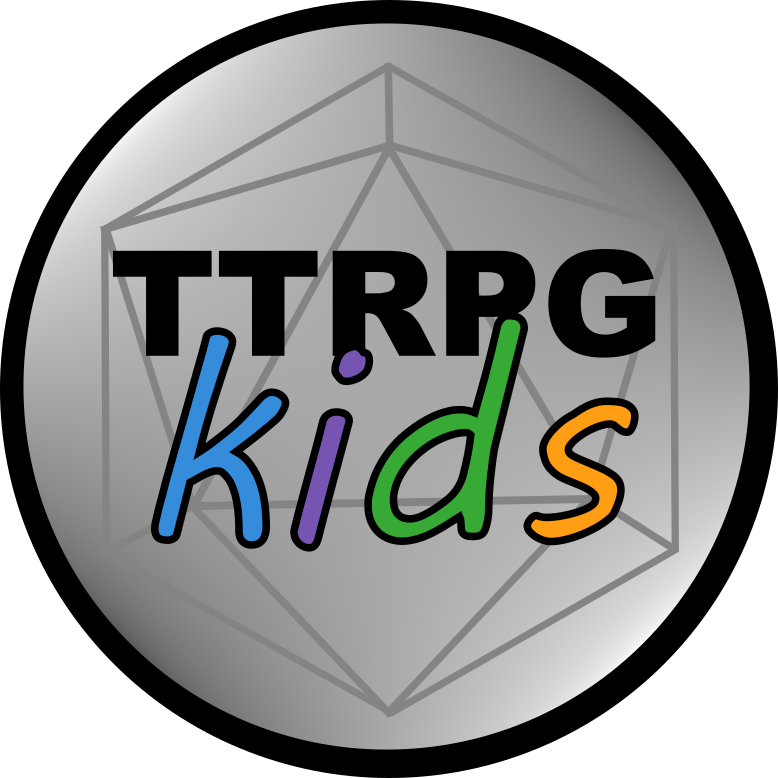Review of Worlds of Pure Imagination, a solo journaling game for young explorers
In this review, I’ll be taking a look at World of Pure Imagination, a space exploration themed TTRPG that uses the Carta System to set you on an adventure through the stars as you journal your way to your missions end goal.
Note: This post may contain affiliate links. At no additional cost to you, I may earn a small commission from purchases made using them. TTRPGkids uses this to keep the site going. Read full disclosure here.
Jump to:
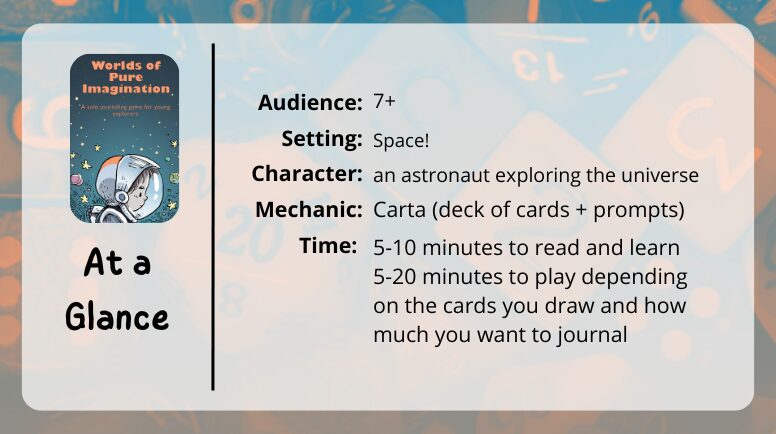
Intended audience for Worlds of Pure Imagination
Worlds of Pure Imagination is made specifically for younger players (I have chatted with the creator on this, but… also… it even says so on the cover)! All of the journaling prompts have all-ages friendly interpretations, usually leaning towards thoughtful responses that also let the player determine how intense anything gets.
Regarding any requirements for using the mechanics, there’s not dice rolling or addition, just matching card numbers and suits to a chart, so players only need to know how to recognize and match numbers/symbols. For reading and writing, this hits at about a 2nd grade reading and writing level (or maybe for an ambitious 1st grader) but can also work for older kids and players. Part of the beauty of journaling games is that it naturally scales, so those still learning to write can give short responses that fit their comfort level… and older players (like myself) can write paragraphs of story if they want.
Setting for Worlds of Pure Imagination
Worlds of Pure Imagination takes place in space! You are searching for some goal (that you determine at the beginning of the game) and will come across curious places and people along the way.
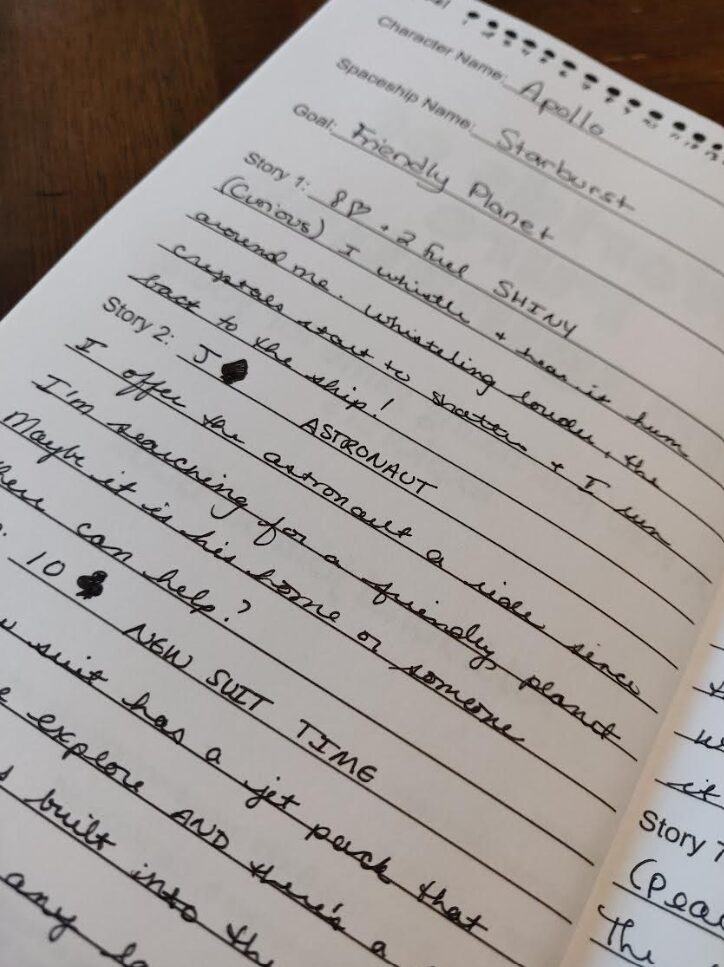
In my playthrough, I explored a world with shifting landscapes, added a stranded astronaut to my crew, later found the astronaut’s lost pet, and stopped a space station from crashing into a sun! I hit 17 prompts in the story that I ran before I got to the card with my missions goal, and each prompt was wildly different from the others… and each had a focus on feelings or awareness or discovery.
There is a strong social-emotional element tied into the prompts, often highlighting a particular feeling that either your character or an NPC may be experiencing in the scene and letting you take it from there to see how it impacts the story. Introducing emotional key words was not only a great way to create engagement and connection with the story’s universe, but also leads the player to reflect and empathize. TTRPGkids is always about that SEL connection in TTRPGs, and this game hit that beat smoothly and simply while keeping the game fun and using it to build the story.
Characters in Worlds of Pure Imagination
Your character in Worlds of Pure Imagination is a space explorer journeying across the universe. You’ll be giving them a name, a spaceship, and a goal before they set off into the wide unknown, and… that’s about all you need to do to mechanically set them up! The rest of their personality will naturally develop as you answer prompts for them and play out their story.
In addition to your own character, you’ll also likely encounter NPCs (I mentioned a lost astronaut before, but I also ran into others). Because you are in charge of where the prompt goes, you’ll be journalng for the NPCs as well. In one of our prompts, my character encountered an angry being in a broken down ship. In my story, I rescued them, found out they were the pirate who tried to come after me a few prompts before, and chatted with them for a bit before offering them a place on my ship… until we got to our final destination at least. I also played out the stranded astronaut and his pet as joining my crew and started to focus more on some of their story elements, which was pretty fun.
Characters in this game are what you make them, and the prompts have just enough nuance to get you into creating some fun personalities.
Mechanics in Worlds of Pure Imagination
Worlds of Pure Imagination is very rules-lite, choosing to focus on journaling elements versus rolling dice or working out stats, and that’s GREAT for what the game aims to accomplish!
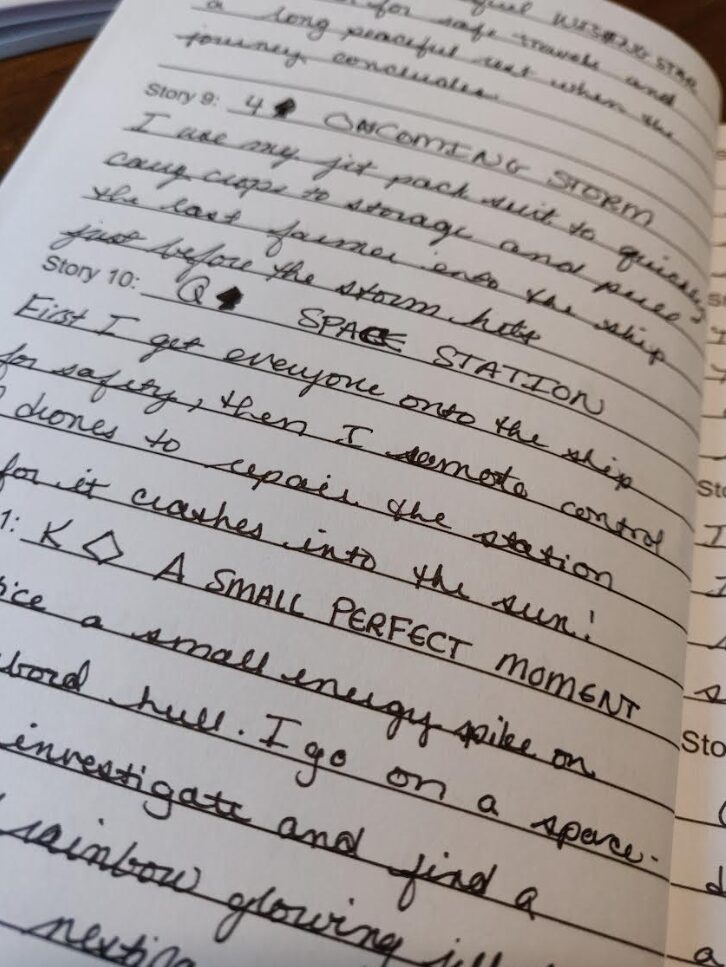
This game uses the Carta system, which involves laying out 24 cards from a standard playing card deck on the table in front of you and uncovering each of them to get your next prompt until you find the specific one tied to your mission’s goal. You’ll match your cards to the prompt tables in the book and journal your responses. The game ends when you find your goal card.
There’s optional fuel mechanics where you start out with a certain amount of fuel in your spaceship and use one fuel per card that you flip over… and gain two fuel if you find a hearts card. I played with the fuel mechanic and… I was VERY close to running out! I had gained fuel so my max went up to 16, and I used all 16 fuel, finding my goal card on the last flip! It added an element of tension without complicating the game, and made it quite satisfying to turn over that final card.
Overall thoughts on Worlds of Pure Imagination
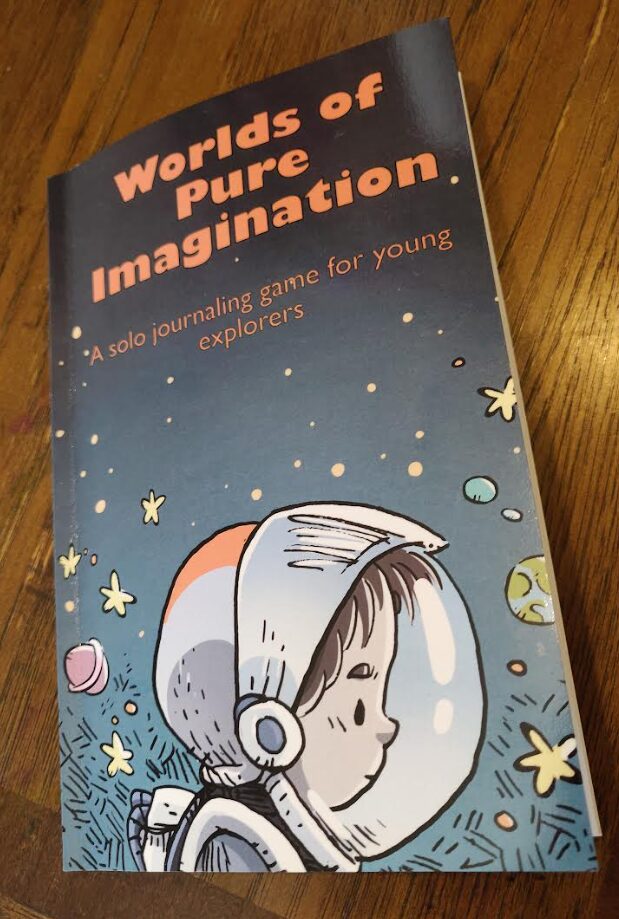
I really enjoyed getting to try out Worlds of Pure Imagination on a chill afternoon because I was able to write without pressure. Kiddo had been in a mood, so not really game for game at the time, but, in the future, I do really want to try suggest this to kiddo later (and maybe also kiddo’s teacher) since I think it is perfect for that 2nd grade reading and writing level…. and it would be a lot of fun to see what new adventures pop up. The prompts were great, the rules were easy to follow, and it’s just an engaging way to playfully practice literacy and empathy.
Find a copy of Worlds of Pure Imagination
You can find a copy of Worlds of Pure Imagination here on DTRPG.
